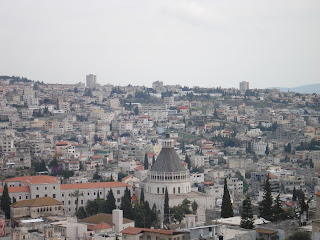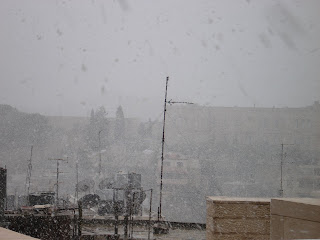
Jim & Annette were with us the entire trip: here they are on the tram going up to Masada

 Jeff "Indiana" Braucher at Caesarea
Jeff "Indiana" Braucher at Caesarea Pastor Azar cooking for us
Pastor Azar cooking for us
Jeries at Masada telling us about "beautiful mosaaaics"
 Masada from a distance
Masada from a distance Exploring Masada
Exploring Masada In front of Cave #4 at Qumran
In front of Cave #4 at Qumran
Floating in the Dead Sea
 Denver doing a reading
Denver doing a reading


Part of our group in the dungeon
 Sandy in Tel Aviv
Sandy in Tel Aviv Sandy on the beach at Caesarea
Sandy on the beach at Caesarea
Standing at the Aquaduct
 View of Armaegeddon from Mt Carmel
View of Armaegeddon from Mt Carmel Posing with Pastor Ajaj & his wife
Posing with Pastor Ajaj & his wife
The view of Nazareth from Pastor Ajaj's house
 A short walk from the Church of Mary’s Well is the largest church in Galilee, The Church of Annunciation. Built over the site tradition identified as the home of Mary, this Catholic Church is filled with beautiful stained glass windows and art. In fact, every nation in the world has donated an art piece to the church representing the angel’s annunciation to Mary. There were two worship services in progress as we visited, a large service in the main sanctuary of the church, and a small service in the lower level in front of the grotto believed to have been the home of Mary. I am always moved when I see people engaged in worshipping the Savior.
A short walk from the Church of Mary’s Well is the largest church in Galilee, The Church of Annunciation. Built over the site tradition identified as the home of Mary, this Catholic Church is filled with beautiful stained glass windows and art. In fact, every nation in the world has donated an art piece to the church representing the angel’s annunciation to Mary. There were two worship services in progress as we visited, a large service in the main sanctuary of the church, and a small service in the lower level in front of the grotto believed to have been the home of Mary. I am always moved when I see people engaged in worshipping the Savior.




Renewing our Vows in Cana
Sepphoris is not mentioned in the NT, which is odd since it is a 40 minute walk from Nazareth and was the capital of the province. It was a much larger city than Nazareth when Jesus lived here and most likely employed most of the men of Nazareth in the extensive building projects. Joseph probably relocated to Nazareth to work as a carpenter in Sepphoris.
After Sepphoris we visited Nazareth Village, a recreation of a portion of Nazareth as it was 2000 years ago. It was very well done. Every thing from the synagogue to the threshing floor were authentic in the way they were created. The young Arab Christian who was our guide through the village was a deeply committed Christian who told the story of Jesus as he explained each part of the village. We had lunch there, and the pastor of a local Baptist church joined us. The most inspiring part of the day was hearing him talk about what God is doing in this place 2000 years after Jesus lived here. Tomorrow we are worshipping at his church and then each one in our group is going home with a church member for to have lunch. I can’t wait!
Reading the scroll in the synagogue of Nazareth
 Lunch: St. Peter's Fish, tilapia
Lunch: St. Peter's Fish, tilapia
 Sandy, looking back at Tiberias
Sandy, looking back at Tiberias
 Church of the Nativity
Church of the Nativity 
 Snowing in Bethlehem
Snowing in Bethlehem The Wall
The Wall Jerusalem
Jerusalem View from Mt Nebo
View from Mt Nebo Sandy and Fadi at the Jordan River
Sandy and Fadi at the Jordan RiverStanding in the "crack in the mountain" about to enter Petra
 "The Treasury" at Petra
"The Treasury" at Petra